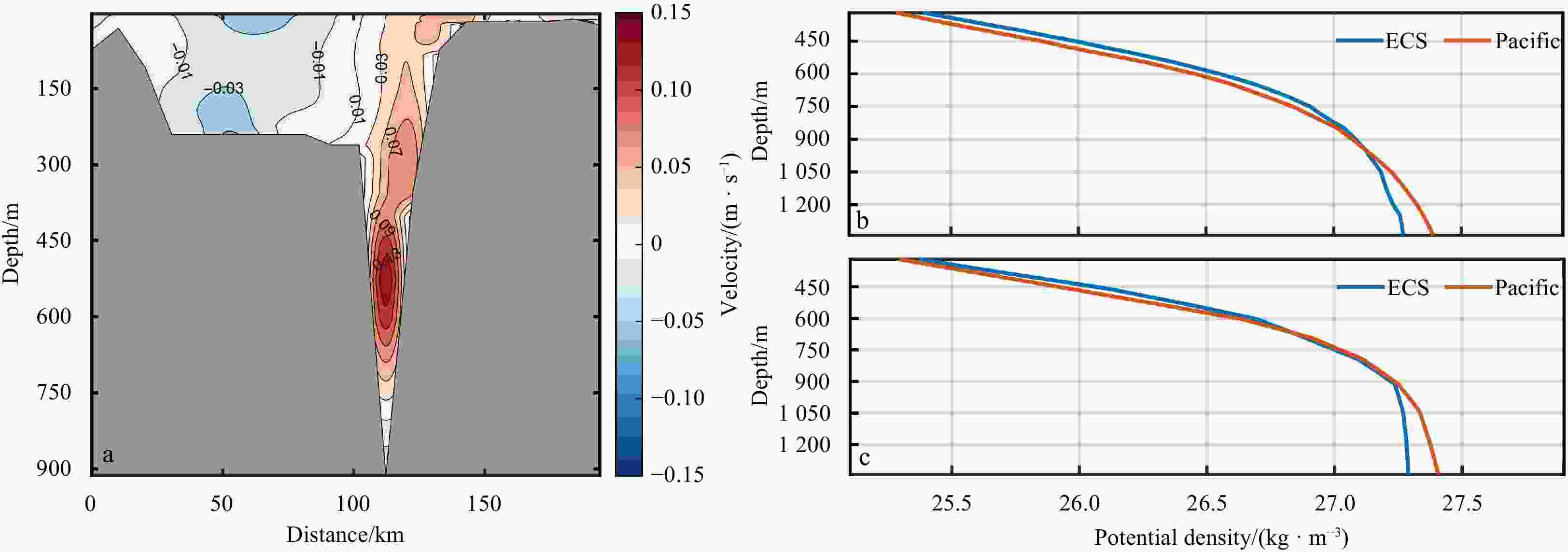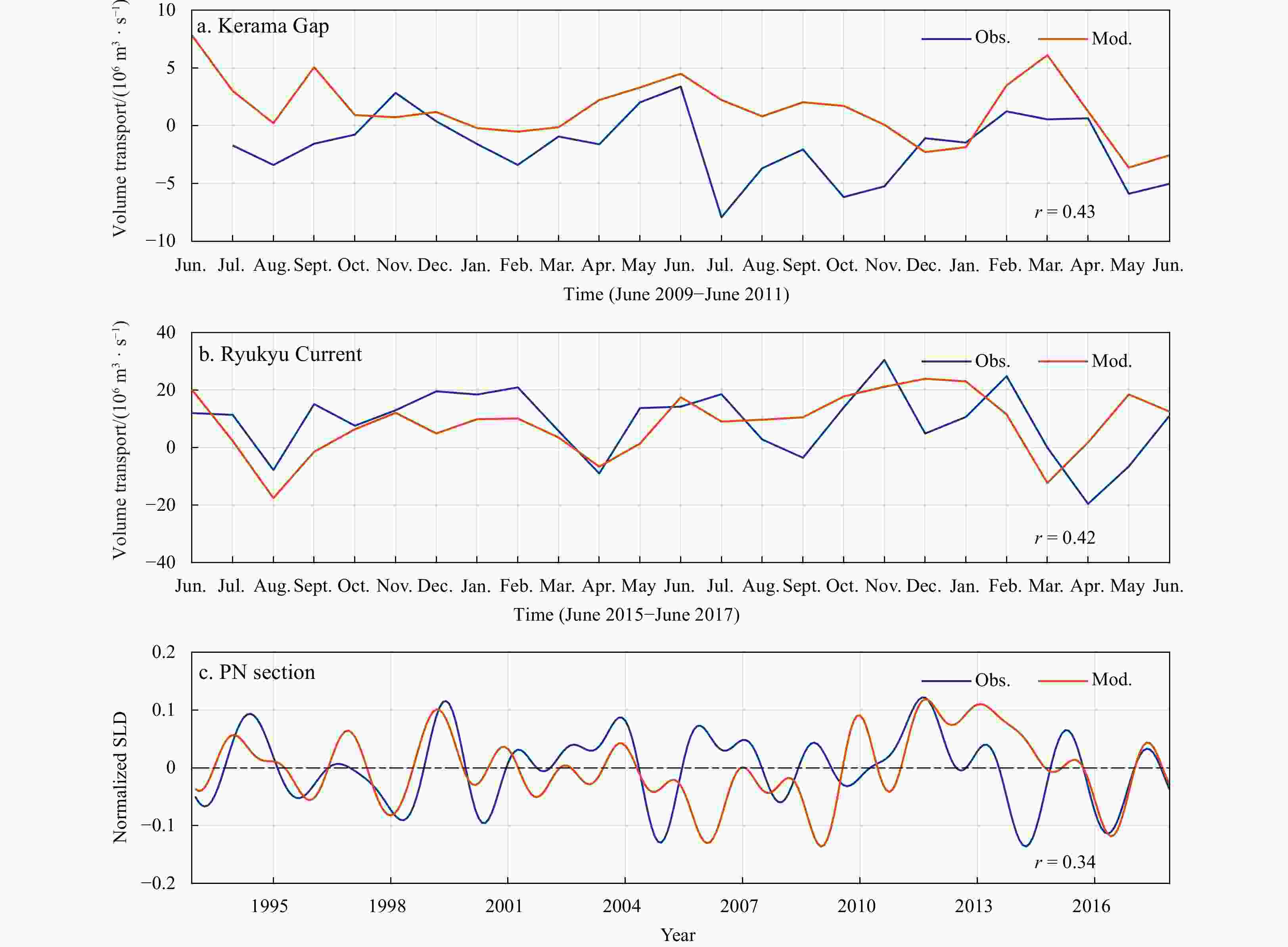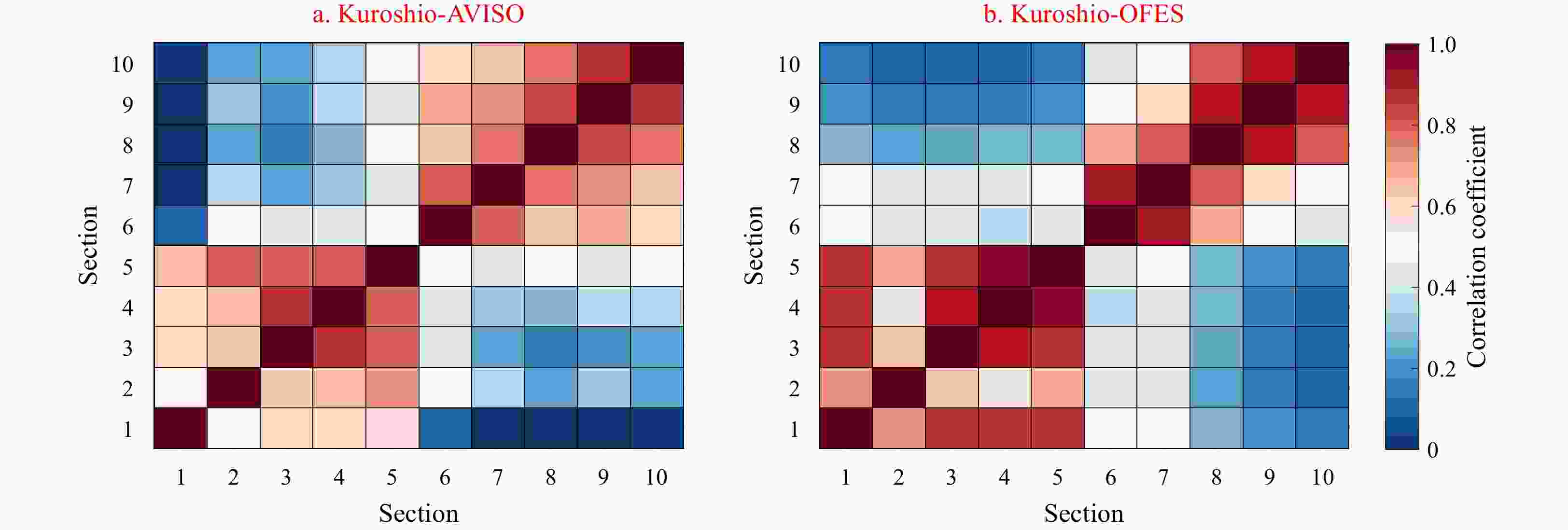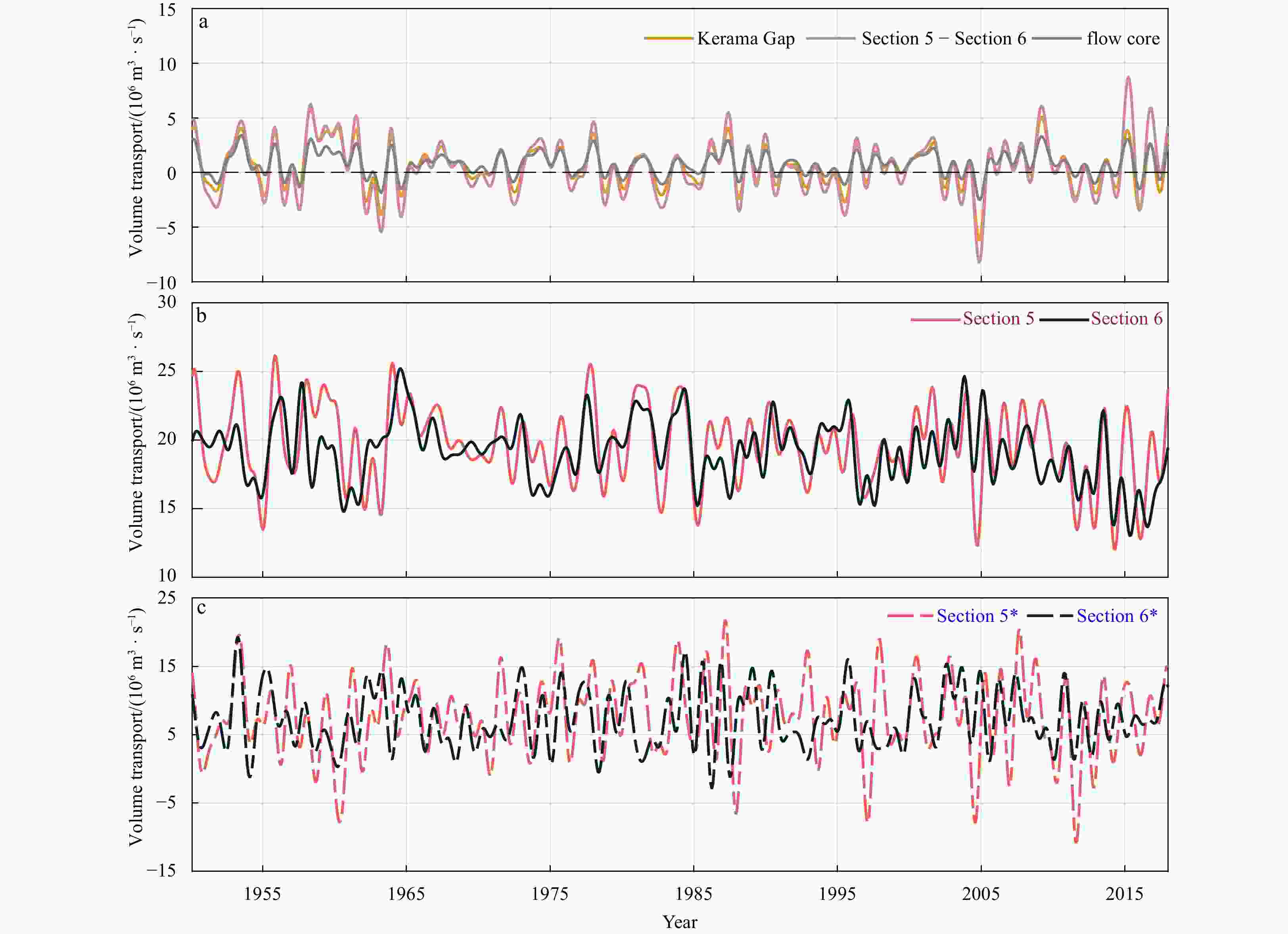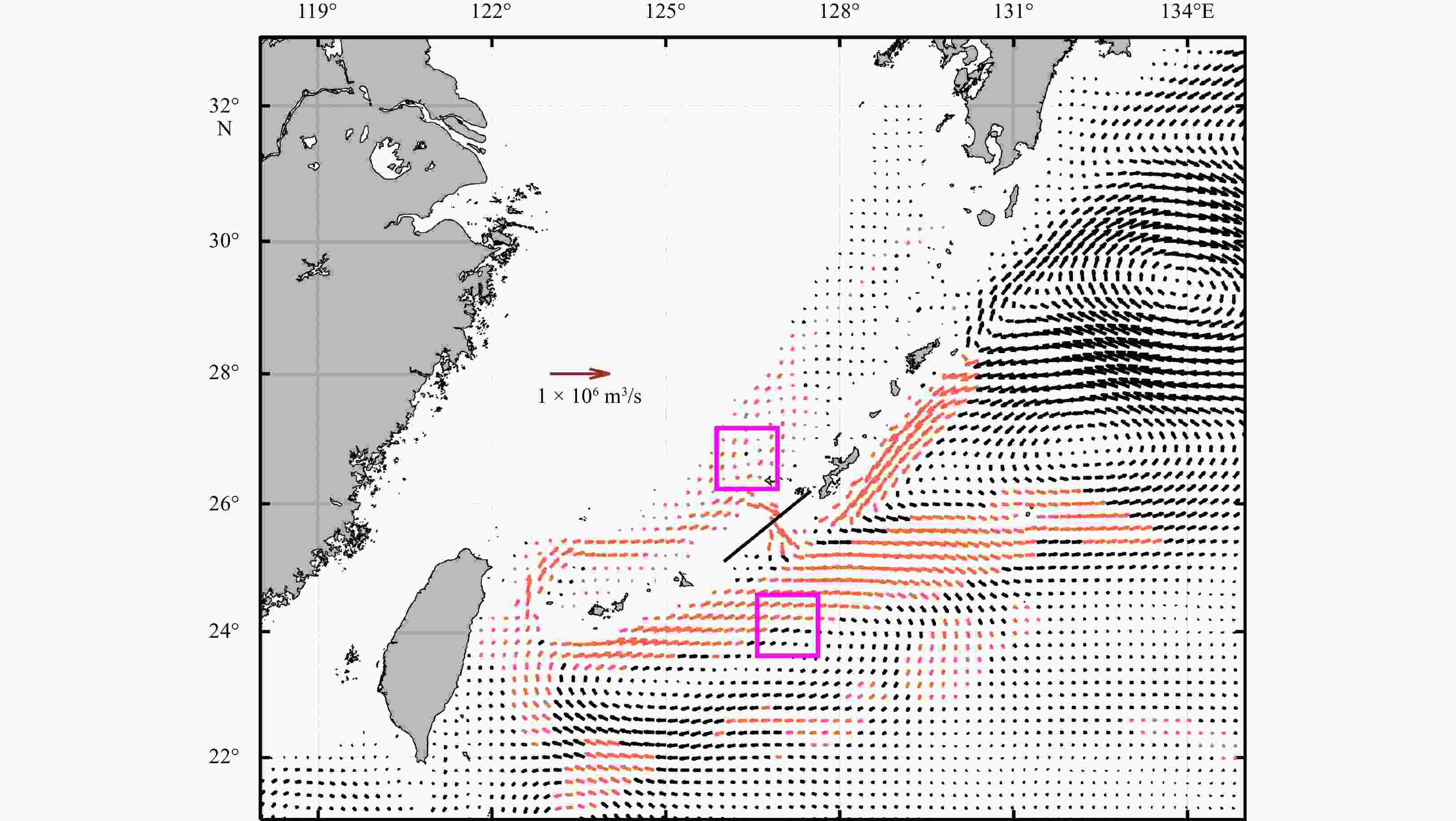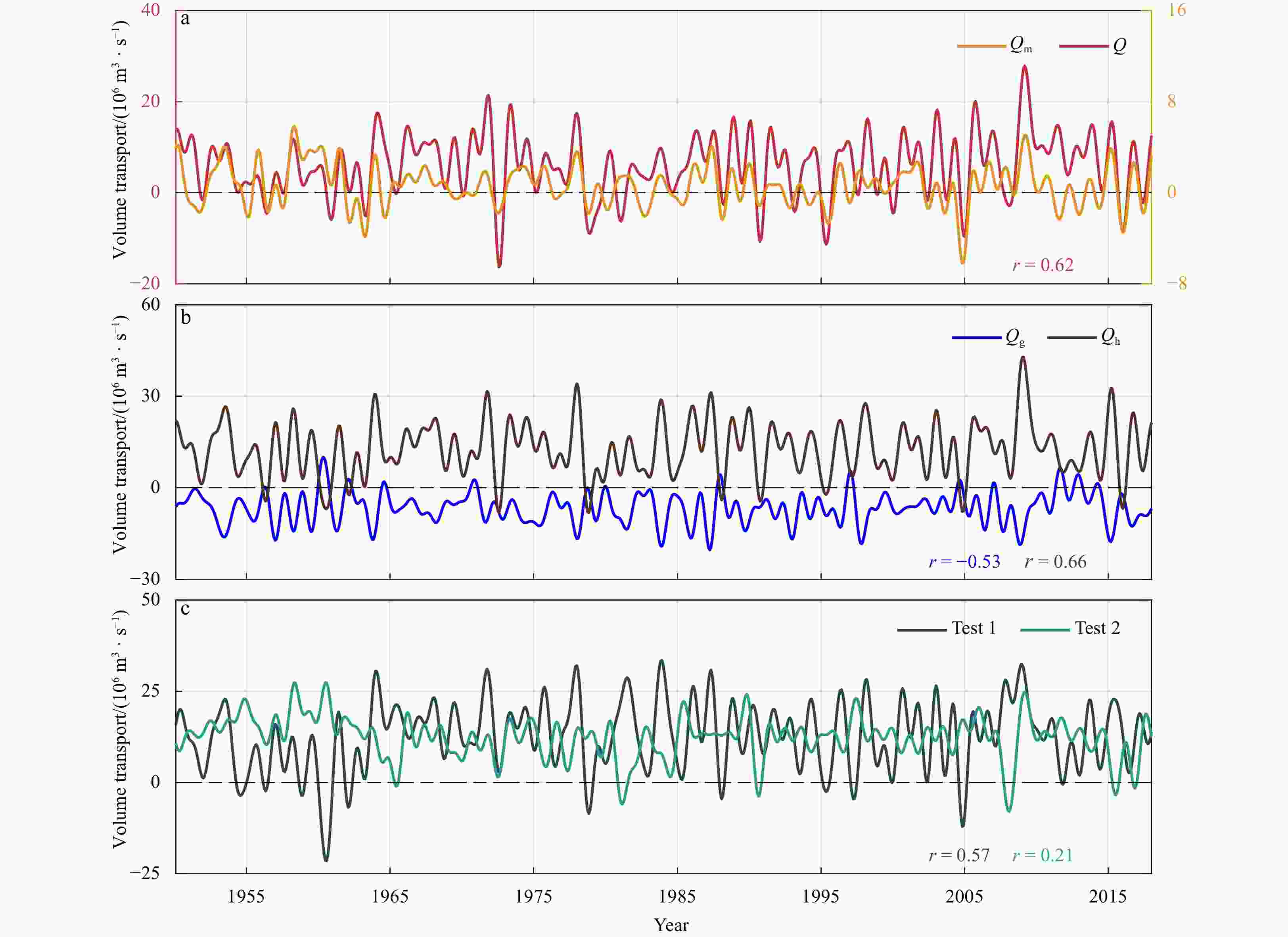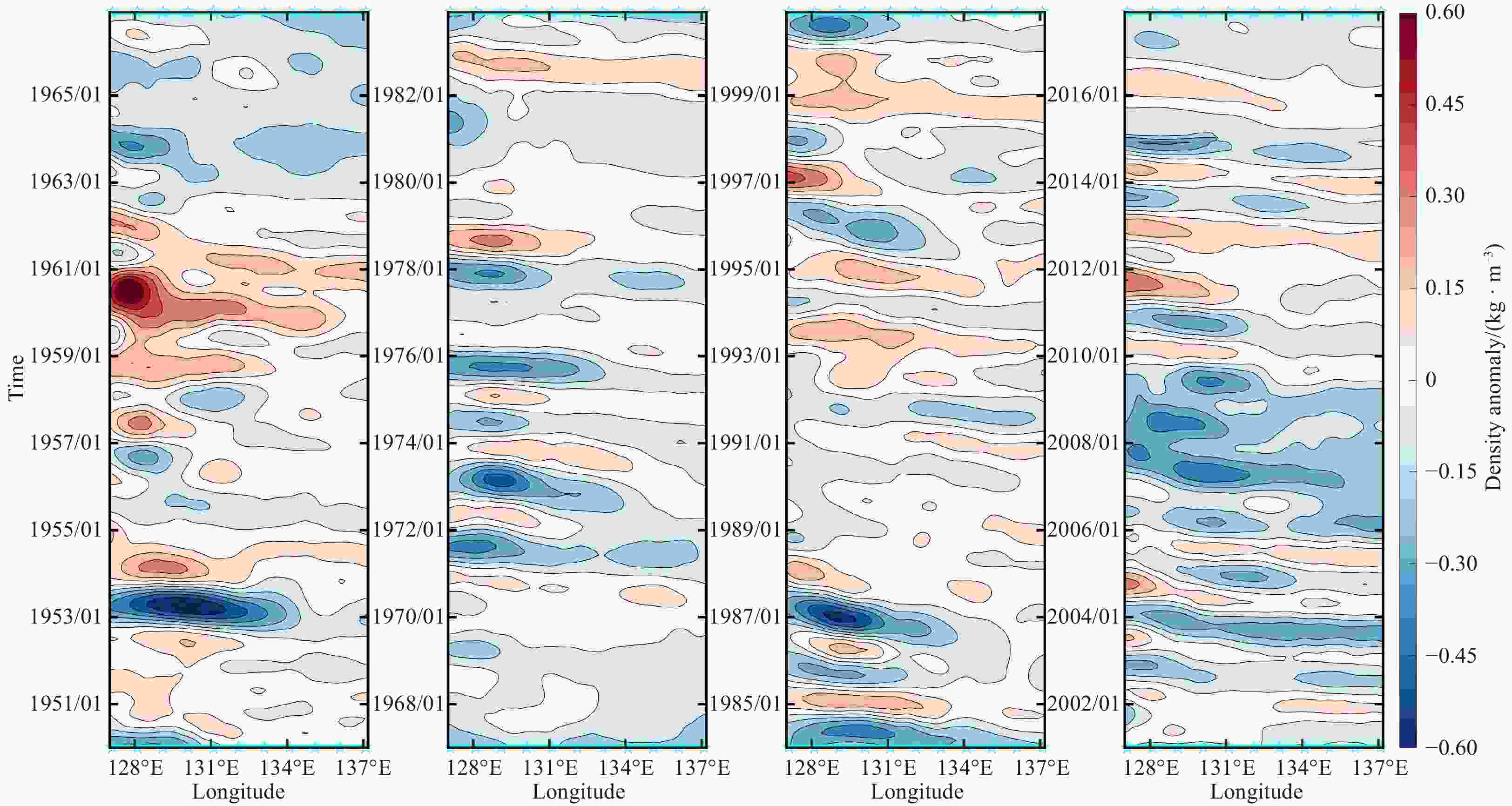Study on the interannual variability of the Kerama Gap transport and its relation to the Kuroshio/Ryukyu Current system
-
Abstract: An analysis of a 68-year monthly hindcast output from an eddy-resolving ocean general circulation model reveals the relationship between the interannual variability of the Kerama Gap transport (KGT) and the Kuroshio/Ryukyu Current system. The study found a significant difference in the interannual variability of the upstream and downstream transports of the East China Sea- (ECS-) Kuroshio and the Ryukyu Current. The interannual variability of the KGT was found to be of paramount importance in causing the differences between the upstream and downstream ECS-Kuroshio. Additionally, it contributed approximately 37% to the variability of the Ryukyu Current. The interannual variability of the KGT was well described by a two-layer rotating hydraulic theory. It was dominated by its subsurface-intensified flow core, and the upper layer transport made a weaker negative contribution to the total KGT. The subsurface flow core was found to be mainly driven by the subsurface pressure head across the Kerama Gap, and the pressure head was further dominated by the subsurface density anomalies on the Pacific side. These density anomalies could be traced back to the eastern open ocean, and their propagation speed was estimated to be about 7.4 km/d, which is consistent with the speed of the local first-order baroclinic Rossby wave. When the negative (positive) density anomaly signal reached the southern region of the Kerama Gap, it triggered the increase (decrease) of the KGT towards the Pacific side and the formation of an anticyclonic (cyclonic) vortex by baroclinic adjustment. Meanwhile, there is an increase (decrease) in the upstream transport of the entire Kuroshio/Ryukyu Current system and an offshore flow that decreases (increases) the downstream Ryukyu Current.
-
Key words:
- Kerama Gap /
- Kuroshio /
- Ryukyu Current /
- OGCM for the Earth Simulator (OFES) /
- hydraulic theory
-
Figure 1. Geographic location and bathymetry of the study area. Vectors represent the climatological mean (1950–2017) surface current field from the OGCM for the Earth Simulator (OFES). The shaded background color represents the water depth (unit: m, the water depth in the yellow area is very shallow). The black line indicates the location of the Kerama Gap. Two pink stars indicate the positions of the vertical potential density profiles on the both sides of the Kerama Gap, which are shown in Fig. 2. Ten red (blue) lines represent ten sections of the ECS-Kuroshio (Ryukyu) Current, while the cyan line denotes the location of the PN section.
Figure 2. Vertical section of the long-term mean velocity (unit: m/s) through the Kerama Gap derived from OFES (a), and a comparison of two long-term mean (1955–2017) vertical potential density profiles on both sides of the Kerama Gap derived from WOA 18 (b) and derived from OFES (c). In a, positive values indicate the flow towards the Pacific Ocean, and distance was measured from the southwestern end of the section depicted in Fig. 1. For b and c, the locations are shown in Fig. 1 (two pink stars), and the red (blue) lines represent the profiles on the Pacific (ECS) side.
Figure 3. Comparison of the transport between the observations (Obs., blue) and the model (Mod., red) (a and b) and normalized sea level difference (SLD) for the PN section (c) . a. Two-year KGT from June 2009 to June 2011, and the observational time series is from Na et al. (2014). b. Two-year Ryukyu Current transport from June 2015 to June 2017, and the observational time series is from Zhao et al. (2020).
Figure 6. The interannual variability of the volume transport through the Kerama Gap (eastward is positive) and the difference between the Section 5 and Section 6 of the ECS-Kuroshio (red) (a), the interannual variability of the volume transport through Section 5 (upstream) and Section 6 (downstream) of the ECS-Kuroshio (northward is positive) (b), and the interannual variability of the volume transport through Section 5* (upstream) and Section 6* (downstream) of the Ryukyu Current (northward is positive) (c) during 1950–2017. In a, the gray line represents the volume transport of the deep flow core between 400 m and 700 m.
Figure 7. Composite analysis of the vertical integrated volume transport (unit: 106 m3/s) for the Kuroshio/Ryukyu Current system using the difference between the positive and negative phase of the KGT (Fig. 6a). Red vectors represent the local transport exceeding the 99% significant level. The two 1° × 1° boxes indicate the region for the calculation of the
$ \Delta \eta $ and$ \Delta h $ . The centers of the ECS and Pacific regions are 26.7°N, 126.4°E and 24.1°N, 127.1°E, respectively.Figure 8. Comparison of the interannual variability of Qm (orange) and Q (red) (a), comparison of the interannual variability of Qg (blue) and Qh (brown) (b), and two sensitivity test results including holding hu constant (Test 1; dark green) and holding hd constant (Test 2; light green) (c). For a, the correlation coefficient is shown at the bottom; for b and c, the correlation coefficients between the two series and Qm and between the two tests and Qm are shown at the bottom, respectively.
Figure 9. Correlation coefficient between
$ {h}_{\mathrm{d}} $ and the local density anomalies at different depths (a), and comparison of the interannual variability of$ {h}_{\mathrm{d}} $ (gray) and local density anomalies at 400 m (yellow) (b). The correlation coefficient is shown at the bottom in b.Figure 11. Composite analysis of the density anomaly (shaded; unit: kg/m3) and horizontal velocity (vector; unit: m/s) at a depth of 400 m, with time leads 8 months (a), 6 months (b), 4 months (c), 2 months (d), and 0 month (e) for the positive KGT year, and the density anomaly and horizontal velocity at a depth of 400 m, with time leads 8 months (f), 6 months (g), 4 months (h), 2 months (i), and 0 month (j) for the negative KGT year. Only the negative density anomaly signals are shown in a–e and only the positive density anomaly signals are shown in f–j. The green line with stars in Fig. 11a represents the path followed to track the westward propagating density anomaly signals. The black line in Fig. 11b shows the section used to plot the vertical distribution of the density anomaly signals (Fig. 12). Ten yellow (purple) lines represent the propagation location of negative (positive) density anomaly signals.
Figure 12. Composite analysis of the vertical distribution of the density anomaly signals (contoured; unit: kg/m3) and the velocity anomalies (shaded; unit: m/s) perpendicular to the section shown in Fig. 11b, with time leads 8 months (a), 6 months (b), 4 months (c), 2 months (d), and 0 month (e) for the positive KGT year, 8 months (f), 6 months (g), 4 months (h), 2 months (i), and 0 month (j) for the negative KGT year. Ten yellow (purple) lines represent the propagation location of negative (postive) density anomaly signals.
Figure 13. Time-dependent SLA during 1993–2017 along the path shown in Fig. 11a (a), interannual variability of the SLA at the westernmost point of the path (b), interannual variability of the SLD between the two endpoints of the section of the Kerama Gap (south minus north) (c), and interannual variability of the SLD between the two endpoints of the Section 5 of the ECS-Kuroshio (east minus west) (d).
Figure 14. A case analysis of the propagation of a positive density during April 1987 to February 1988. The vector represents the horizontal velocity and the shading represents the density anomaly at 500 m depth. The green line with stars represents the path followed to track the westward propagating density anomaly signals.
Table 1. Correlation coefficients between the KGT and ten sections of the vertically integrated volume transport for ECS-Kuroshio and Ryukyu Current
Section Correlation coefficient ECS-Kuroshio Ryukyu Current 1 0.68 0.46 2 0.62 0.43 3 0.70 0.50 4 0.74 0.48 5 0.74 0.33 6 –0.27 –0.27 7 –0.25 –0.49 8 –0.30 –0.53 9 –0.31 –0.37 10 –0.33 –0.42 Note: The bold correlation coefficient values are significant at the 99% significance level. -
Andres M, Park J H, Wimbush M, et al. 2008. Study of the Kuroshio/Ryukyu Current system based on satellite-altimeter and in situ measurements. Journal of Oceanography, 64(6): 937–950, doi: 10.1007/s10872-008-0077-2 Chelton D B, deSzoeke R A, Schlax M G, et al. 1998. Geographical variability of the first baroclinic Rossby radius of deformation. Journal of Physical Oceanography, 28(3): 433–460, doi: 10.1175/1520-0485(1998)028<0433:GVOTFB>2.0.CO;2 Gao Jie, Guo Xinyu, Yoshie N, et al. 2022. Occurrence of surface phytoplankton bloom as the Kuroshio Current passes an island. Journal of Geophysical Research: Oceans, 127(9): e2021JC018242, doi: 10.1029/2021JC018242 Garrett C, Toulany B. 1982. Sea level variability due to meteorological forcing in the northeast Gulf of St. Lawrence. Journal of Geophysical Research: Oceans, 87(C3): 1968–1978, doi: 10.1029/JC087iC03p01968 Guo Xinyu, Zhu Xiaohua, Wu Qingsong, et al. 2012. The Kuroshio nutrient stream and its temporal variation in the East China Sea. Journal of Geophysical Research: Oceans, 117(C1): C01026 Hsin Y C, Qiu Bo, Chiang T L, et al. 2013. Seasonal to interannual variations in the intensity and central position of the surface Kuroshio east of Taiwan. Journal of Geophysical Research: Oceans, 118(9): 4305–4316, doi: 10.1002/jgrc.20323 Ichikawa H, Nakamura H, Nishina A, et al. 2004. Variability of northeastward current southeast of northern Ryukyu Islands. Journal of Oceanography, 60(2): 351–363, doi: 10.1023/B:JOCE.0000038341.27622.73 Jin Baogang, Wang Guihua, Liu Yonggang, et al. 2010. Interaction between the East China Sea Kuroshio and the Ryukyu Current as revealed by the self-organizing map. Journal of Geophysical Research: Oceans, 115(C12): C12047 Liu Zhaojun, Zhu Xiaohua, Wang Min, et al. 2020. Variability of the deep overflow through the Kerama Gap revealed by observational data and global ocean reanalysis. Journal of Marine Science and Engineering, 8(6): 402, doi: 10.3390/jmse8060402 Na Hanna, Wimbush M, Park J H, et al. 2014. Observations of flow variability through the Kerama Gap between the East China Sea and the Northwestern Pacific. Journal of Geophysical Research: Oceans, 119(2): 689–703, doi: 10.1002/2013JC008899 Nakamura H, Ichikawa H, Nishina A. 2007. Numerical study of the dynamics of the Ryukyu Current system. Journal of Geophysical Research: Oceans, 112(C4): C04016 Nakamura H, Nishina A, Liu Zhaojun, et al. 2013. Intermediate and deep water formation in the Okinawa Trough. Journal of Geophysical Research: Oceans, 118(12): 6881–6893, doi: 10.1002/2013JC009326 Nishina A, Nakamura H, Park J H, et al. 2016. Deep ventilation in the Okinawa Trough induced by Kerama Gap overflow. Journal of Geophysical Research: Oceans, 121(8): 6092–6102, doi: 10.1002/2016JC011822 Qiu Bo, Chen Shuiming. 2010. Interannual to decadal variability in the bifurcation of the North Equatorial Current off the Philippines. Journal of Physical Oceanography, 40(11): 2525–2538, doi: 10.1175/2010JPO4462.1 Qu Tangdong, Girton J B, Whitehead J A. 2006. Deepwater overflow through Luzon Strait. Journal of Geophysical Research: Oceans, 111(C1): C01002 Qu Tangdong, Song Y T. 2009. Mindoro Strait and Sibutu Passage transports estimated from satellite data. Geophysical Research Letters, 36(9): L09601 Ram V S S, Kayastha N, Sha Kewei. 2022. OFES: optimal feature evaluation and selection for multi-class classification. Data & Knowledge Engineering, 139: 102007 Sasaki H, Sasai Y, Kawahara S, et al. 2004. A series of eddy-resolving ocean simulations in the world ocean-OFES (OGCM for the Earth Simulator) project. In: Oceans '04 MTS/IEEE Techno-Ocean '04 (IEEE Cat. No. 04CH37600). Kobe, Japan: IEEE,1535–1541 Soeyanto E, Guo Xinyu, Ono J, et al. 2014. Interannual variations of Kuroshio transport in the East China Sea and its relation to the Pacific Decadal Oscillation and mesoscale eddies. Journal of Geophysical Research: Oceans, 119(6): 3595–3616, doi: 10.1002/2013JC009529 Song Y T. 2006. Estimation of interbasin transport using ocean bottom pressure: theory and model for Asian marginal seas. Journal of Geophysical Research, 111(C11): C11S19 Susanto R D, Song Y T. 2015. Indonesian throughflow proxy from satellite altimeters and gravimeters. Journal of Geophysical Research: Oceans, 120(4): 2844–2855, doi: 10.1002/2014JC010382 Thoppil P G, Metzger E J, Hurlburt H E, et al. 2016. The current system east of the Ryukyu Islands as revealed by a global ocean reanalysis. Progress in Oceanography, 141: 239–258, doi: 10.1016/j.pocean.2015.12.013 Wang Youlin, Wu Chau-Ron. 2018. Discordant multi-decadal trend in the intensity of the Kuroshio along its path during 1993–2013. Scientific Reports, 8(1): 14633, doi: 10.1038/s41598-018-32843-y Whitehead J A, Leetmaa A, Knox R A. 1974. Rotating hydraulics of strait and sill flows. Geophysical Fluid Dynamics, 6(2): 101–125, doi: 10.1080/03091927409365790 Xu Lixiao, Li Peiliang, Xie Shangping, et al. 2016. Observing mesoscale eddy effects on mode-water subduction and transport in the North Pacific. Nature Communications, 7: 10505, doi: 10.1038/ncomms10505 Xu Lixiao, Xie Shangping, McClean J L, et al. 2014. Mesoscale eddy effects on the subduction of North Pacific mode waters. Journal of Geophysical Research: Oceans, 119(8): 4867–4886, doi: 10.1002/2014JC009861 Yu Zhitao, Metzger E J, Hurlburt H E, et al. 2019. What controls the extreme flow through the Kerama Gap: a global HYbrid coordinate ocean model reanalysis point of view. Ocean Dynamics, 69(8): 899–911, doi: 10.1007/s10236-019-01284-0 Yu Zhitao, Metzger E J, Thoppil P, et al. 2015. Seasonal cycle of volume transport through Kerama Gap revealed by a 20-year global HYbrid coordinate ocean model reanalysis. Ocean Modelling, 96: 203–213, doi: 10.1016/j.ocemod.2015.10.012 Yuan Yaochu, Kaneko A, Su Jilan, et al. 1998. The Kuroshio east of Taiwan and in the East China Sea and the currents east of Ryukyu Islands during early summer of 1996. Journal of Oceanography, 54(3): 217–226, doi: 10.1007/BF02751697 Zhao Ruixiang, Nakamura H, Zhu Xiaohua, et al. 2020. Tempo-spatial variations of the Ryukyu Current southeast of Miyakojima Island determined from mooring observations. Scientific Reports, 10(1): 6656, doi: 10.1038/s41598-020-63836-5 Zhou Wenzheng, Yu Fei, Nan Feng. 2017. Water exchange through the Kerama Gap estimated with a 25-year Pacific hybrid coordinate ocean model. Chinese Journal of Oceanology and Limnology, 35(6): 1287–1302, doi: 10.1007/s00343-017-6141-2 Zhou Wenzheng, Yu Fei, Nan Feng, et al. 2018. Effects of mesoscale eddies on the variation of water exchange through the Kerama Gap. Journal of Oceanography, 74(3): 263–275, doi: 10.1007/s10872-017-0456-7 Zhu Xiaohua, Han In-Seong, Park J H, et al. 2003. The northeastward current southeast of Okinawa Island observed during November 2000 to August 2001. Geophysical Research Letters, 30(2): 1071 Zhu Xiaohua, Huang Daji, Guo Xinyu. 2010. Autumn intensification of the Ryukyu Current during 2003–2007. Science China Earth Sciences, 53(4): 603–609, doi: 10.1007/s11430-010-0022-2 -




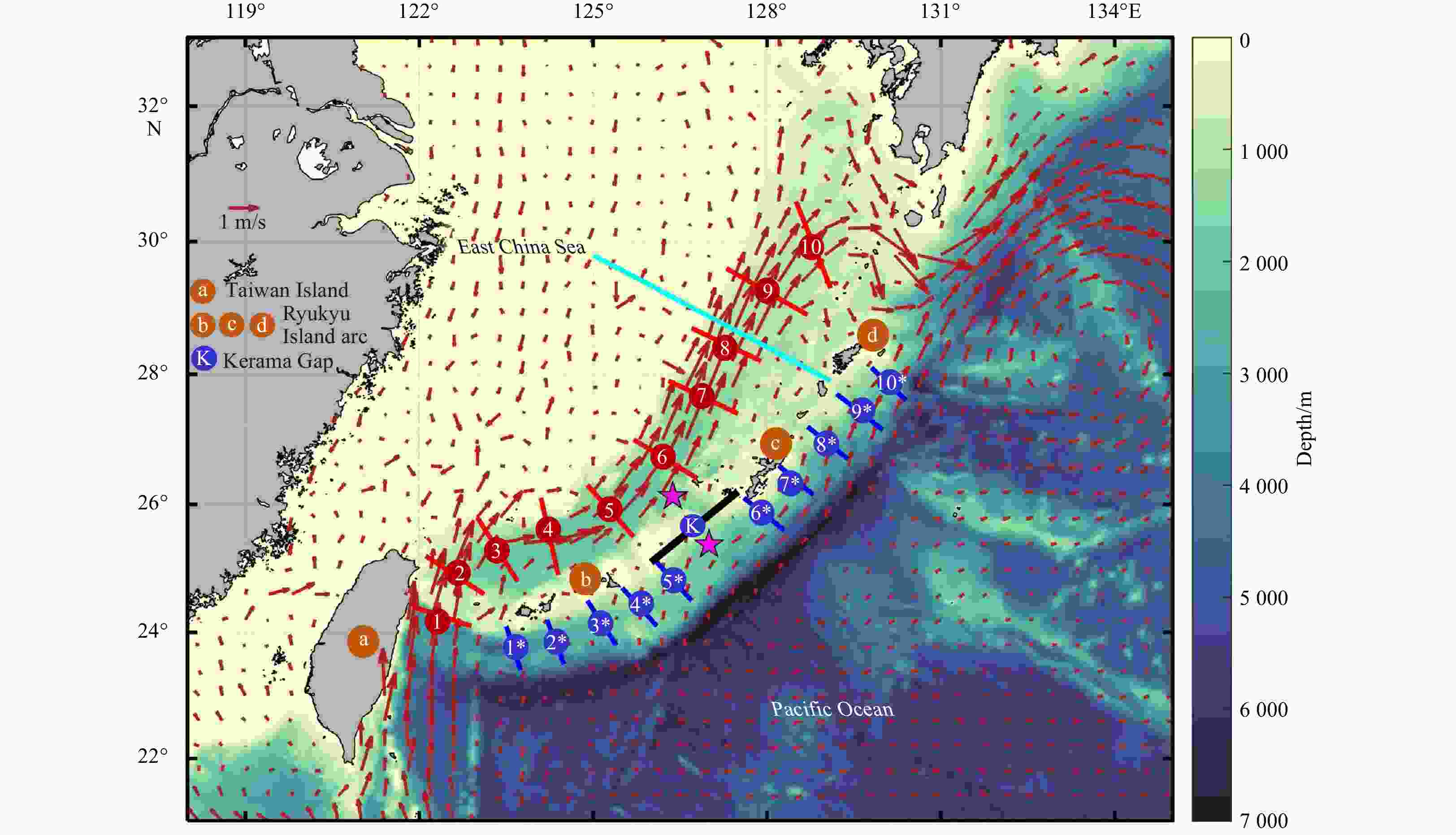
 下载:
下载:
